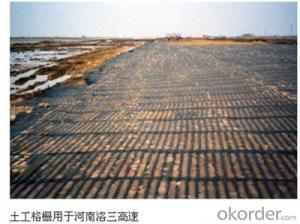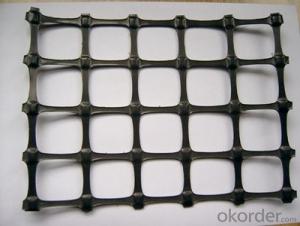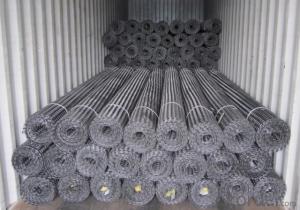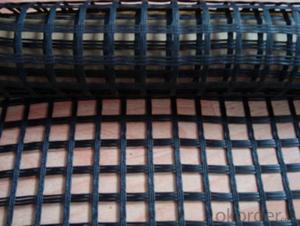Uniaxial Plastic Geogrid CE certificate good quality
- Loading Port:
- Tianjin
- Payment Terms:
- TT OR LC
- Min Order Qty:
- 888 m²
- Supply Capability:
- 1800000 m²/month
OKorder Service Pledge
OKorder Financial Service
You Might Also Like
1.Structure of Uniaxial Plastic Geogrid descriptions:
It is is a smooth high density proethylene(HDPE) Geogrid manufactured with the highest quality . This product is used in applications that require excellent chemical resisitance and endurance properties.
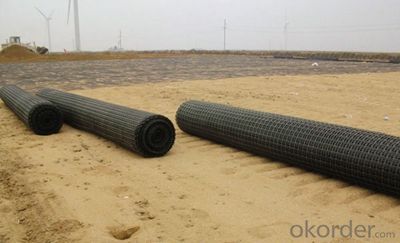
Features of Uniaxial plastic Geogrid :
High strength , Good flexibility, anti-aging, resisting acid and Alkaline.
Usage of Uniaxial Plastic Geogrid :
Make reinforcement for various kinds of soil foundation enhance and improve bearing ability if the roadbed .make reinforcement for retaining wall, steep slope, dam and bridge abutment under stress status for long term thus to improve quality and prolong service life of the project .
Specification of the Uniaxial Geogrid
TGDG35 TGDG50 TGDG80 TGDG110 TGDG120
Width : <= 2.5m
Length : 50—100m
Color : black
Packaging : Each roll is wrapped in a woven bag then into container Or Packed as customers' requests.
Production periods: within 15 days after receiving the deposit
Introduction of CNBM
China National Building Materials (Group) Corporation (CNBM) is a state-owned enterprise in charge of administrative affairs in China building materials industry. Established in 1984, CNBM is a large group corporation of building materials with total assets of RMB 25 billion and a total staff of 30,000. Now CNBM owns more than 200 subsidiaries in and abroad the country, including wholly-owned corporations and joint ventures.
FAQ of geosynthetics :
What is geosynthetics ?
Geosynthetics form a perfect erosion control fabric used extremely widely in civil engineering to stabilize and reinforce slopes and soil under or next to roads, railways, dams, water reservoirs etc.. They can be easily applied which minimizes the time of construction, as well as they limit the resources and materials necessary.
What kinds of geosynthetics we have ?
Non-woven geotextile, geogrids, geocells, GCL, Geomembranes, Geonets, Geocomposites etc .
What is the geosynthetics used for ?
Hydraulic
Lagooning and Water Treatment, Ornamental Ponds, Golf Courses
Aquaculture and Desalination,Water Lagoons,Tanks, Reservoirs, Liquid Waste,Floating Cover Solutions, Drainage and Filtration
Environment
Tailing ponds, Leach mining,Landfills,Landfill Capping,Protection against corrosion,Vertical Barriers
Civil Works
Erosion Control,Secondary Containment,Tunnels,Linear and Surface Works,Consolidation of Margins,Soil Reinforcement,Soil Separation.
Building - Parkings,Roofing,Soundproofing
- Q:What is the difference between unidirectional geogrid and two-way geogrid
- An efficient stress transfer mechanism is formed, so that the local load can be quickly and effectively spread to a large area of soil, so as to achieve the purpose of reducing the local failure stress and improving the service life of the project.
- Q:Can geogrids be used in geotechnical engineering?
- Yes, geogrids can be used in geotechnical engineering. Geogrids are commonly used for soil stabilization, reinforcement of retaining walls, and improving the performance of paved and unpaved roads. They provide tensile strength to soils and help distribute loads more efficiently, making them a valuable tool in geotechnical engineering projects.
- Q:How do geogrids reduce settlement in embankments?
- Geogrids reduce settlement in embankments by providing reinforcement and improving stability. They distribute loads more evenly across the soil, preventing excessive consolidation and settlement. Moreover, the geogrids also enhance the bearing capacity of the embankment, preventing soil failure and reducing settlement further.
- Q:How do geogrids improve the performance of reinforced soil slopes in seismic areas?
- Geogrids improve the performance of reinforced soil slopes in seismic areas by providing additional stability and strength to the soil structure. They work by distributing and transferring the forces generated during an earthquake throughout the soil mass, reducing the risk of slope failure. Geogrids also enhance the overall tensile strength of the soil, preventing excessive deformation and maintaining the integrity of the slope.
- Q:Can geogrids be used in floating parking lot construction?
- Yes, geogrids can be used in floating parking lot construction. Geogrids are often used as reinforcement materials to stabilize the ground and provide additional support for the parking lot. They help distribute the load evenly, prevent soil erosion, and increase the overall stability of the parking lot structure, making them suitable for floating parking lot construction.
- Q:How do geogrids help in reducing the risk of differential settlement of structures?
- Geogrids help in reducing the risk of differential settlement of structures by providing reinforcement and improving the load-bearing capacity of the soil. They act as a stabilizing layer, distributing vertical and horizontal forces evenly, which prevents uneven settling of the foundation. This helps maintain the structural integrity of the building and minimizes the potential for damage or structural failure.
- Q:What are the differences between geogrids and geonets?
- Geogrids and geonets are both geosynthetic materials used in civil engineering and geotechnical applications, but they have distinct differences. Geogrids are typically composed of high-strength polymers or fiberglass with a grid-like structure, offering tensile reinforcement to soil or other materials. They are primarily used for soil stabilization, slope reinforcement, and retaining wall construction. On the other hand, geonets are three-dimensional, open-mesh structures made of polymer materials. Geonets provide drainage and filtration capabilities, making them suitable for applications such as landfill leachate collection, erosion control, and gas venting. While geogrids focus on soil reinforcement, geonets specialize in drainage and filtration functions.
- Q:What are the factors that affect the design and selection of geogrids for geosynthetic reinforcement of slopes?
- There are several factors that affect the design and selection of geogrids for geosynthetic reinforcement of slopes. These factors include the slope angle, soil type and properties, required design life, anticipated loading conditions, and installation constraints. Additionally, factors such as cost, availability, and environmental considerations may also play a role in the selection process. Overall, a comprehensive assessment of these factors is crucial to ensure the appropriate geogrid is chosen to effectively reinforce and stabilize slopes.
- Q:How do geogrids help in reducing the risk of soil liquefaction?
- Geogrids help in reducing the risk of soil liquefaction by reinforcing the soil structure and improving its stability. They act as a barrier against lateral movement of soil particles during an earthquake, thereby preventing the formation of liquefied zones. The geogrids increase the shear strength and bearing capacity of the soil, making it less susceptible to liquefaction-induced damage.
- Q:Can geogrids withstand heavy loads?
- Yes, geogrids are designed to withstand heavy loads. They are commonly used in civil engineering and construction projects to reinforce soil and provide stability, even under significant weight or pressure. Geogrids have high tensile strength and durability, enabling them to effectively distribute and transfer loads, making them suitable for various applications such as roadways, retaining walls, and reinforced slopes.
1. Manufacturer Overview |
|
|---|---|
| Location | |
| Year Established | |
| Annual Output Value | |
| Main Markets | |
| Company Certifications | |
2. Manufacturer Certificates |
|
|---|---|
| a) Certification Name | |
| Range | |
| Reference | |
| Validity Period | |
3. Manufacturer Capability |
|
|---|---|
| a)Trade Capacity | |
| Nearest Port | |
| Export Percentage | |
| No.of Employees in Trade Department | |
| Language Spoken: | |
| b)Factory Information | |
| Factory Size: | |
| No. of Production Lines | |
| Contract Manufacturing | |
| Product Price Range | |
Send your message to us
Uniaxial Plastic Geogrid CE certificate good quality
- Loading Port:
- Tianjin
- Payment Terms:
- TT OR LC
- Min Order Qty:
- 888 m²
- Supply Capability:
- 1800000 m²/month
OKorder Service Pledge
OKorder Financial Service
Similar products
New products
Hot products
Hot Searches
Related keywords
